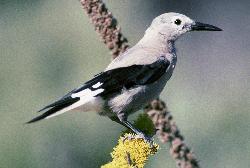
Courtesy US Fish & Wildlife Service
Dave Menke, Photographer
Lewis and Clark have left their names on many plants and animals in our western mountains. The Clark’s Nutcracker, a member of the jay family, has a long list of special attributes well beyond the norm.
This “forester bird” has planted countless millions of trees from Canada to Mexico, provided food for many other critters including the mighty grizzly bear, and has amazed animal behaviorists with their uncanny recall ability.
Nutcrackers often bury their seeds at the perfect depth for germination. They bury pine seeds in hidden caches in fall, then re-find them during winter, allowing them to nest in late winter, when the forest is still covered with snow. They bury clusters of four or five seeds per location caching up to 500 seeds per hour. They often hide seeds near the base of tree trunks, a tendency that may play an important role in their spatial memory system. Landmarks help nutcrackers remember the precise locations of caches.
By the end of the fall, each nutcracker has stashed tens of thousands of seeds. Clark’s spend so much time hacking apart pinecones that sticky resin sometimes dyes their grey feathers a reddish-purple color. But the prize is worth the effort: Pine seeds are a nutritious food, packed with fats, proteins, and carbs.
Crucially, the birds will hide seeds as far as 20 miles away from their source trees. In doing so, they help trees expand their territory into new areas. As development continues to fragment forests and climate change demands rapid migration, “animals that move between patches of habitat are increasing in importance.
Other feeding habits include catches flying insects in the air, digging insect larvae out of wood, eating berries, insects, snails, eggs, carrion, and even young of other birds, which I observed directly near White Pine Lake in the Bear River range. Knowing them as a seed eater, I stunned to watch as a mixed flock of forest birds mobbed the Clarks who had a youngster in its beak it had plucked from its nest.
Nutcrackers have an especially close relationship with the whitebark pine. Unlike other pines, whitebark seeds don’t have “wings” that let them ride gusts of wind across the landscape. Instead, the seeds and cones seem optimized for a nutcracker’s bill, and as such, the trees rely on the birds’ forgetfulness to reproduce. It’s possible that the birds could play a part in helping the whitebark pine recover. Human foresters are now studying how to attract Clark’s Nutcrackers to aid in forest restoration.
Climate change is forecast by Audubon’s climate model to decrease winter and summer range by roughly equal amounts—around 70 percent by 2080. Tied as this species is to the high western coniferous forests, it seems unlikely it will be able to adapt to any new shifting climate space, as is true with another favorite subalpine resident- the pica, a miniature member of the rabbit family.
Jack Greene, Getting wilder about Utah by the minute!
Credits:
Images: Courtesy Jack Greene
Audio: Contains Audio Courtesy and Copyright Kevin Colver
Text: Jack Greene
Sources & Additional Reading:
Kervin, Linda, Lewis and Clark’s Taxonomic Legacy, Wild About Utah, Nov 3, 2011, https://wildaboututah.org/lewis-and-clarks-taxonomic-legacy/
Strand, Holly, Cache and Retrieve, Wild About Utah, Jan 19, 2012, https://wildaboututah.org/cache-and-retrieve/
Larese-Casanova, Mark, Nutcrackers and Squirrels, Farmers of the Forests, Wild About Utah, Aug 26, 2013, https://wildaboututah.org/nutcrackers-squirrels-farmers-forests/
Clark’s Nutcracker Identification, All About Birds, The Cornell Lab of Ornithology, https://www.allaboutbirds.org/guide/Clarks_Nutcracker/id?gclid=EAIaIQobChMIoL3708zi3wIVCtNkCh2bVAg1EAAYASAAEgKk3vD_BwE
Clark’s Nutcracker, Nucifraga columbiana, Audubon Field Guide, National Audubon Society, https://www.audubon.org/field-guide/bird/clarks-nutcracker
